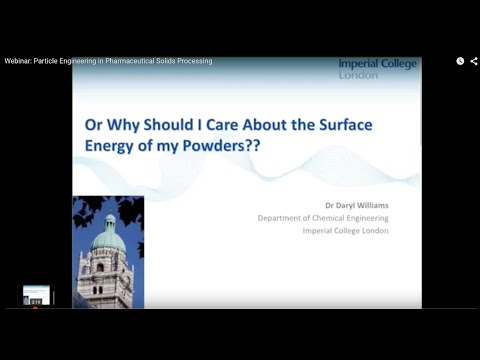
Sorption Science Webinars/Workshops Directory
To keep up to date with our upcoming events please visit: https://www.surfacemeasurementsystems.com/learning-center/webinars/
| Responsible | Daniel Villalobos |
|---|---|
| Last Update | 24/04/2025 |
| Completion Time | 1 day 4 hours 1 minute |
| Members | 240 |

Webinar title: Particle Engineering in Pharmaceutical Solids Processing: Surface Energy Considerations
Topic: This webinar presented by Dr Daryl Williams from Imperial College London reviews the surface energy and surface energy heterogeneity of crystalline solids, methods for the measurement of surface energy, effects of milling on powder surface energy, adhesion and cohesion on powder mixtures, crystal habits and surface energy, surface energy and powder granulation processes.
For more information visit our website:
www.surfacemeasurementsystems.com
LinkedIn: https://www.linkedin.com/company/surface-measurement-systems
Twitter: https://twitter.com/surfacemsystems
Cellulose
View all
Surface Measurement Systems and the University of British Columbia collaborated to provide three in-depth presentations exploring the latest research, case studies, and findings. This workshop offers unparalleled insight into the use of sorption science techniques in the field of cellulosic materials and characterization.
Characterization of Cellulose-based Materials by Dynamic Vapor Sorption with Dr. Daniel Burnett
Cellulose is the most abundant organic polymer on Earth, and can be found in plants, marine animals, algae, and bacteria. Depending on the source of the cellulose and the chemical treatment, the resulting material can vary in crystal structure, degree of crystallinity, surface chemistry, morphology and aspect ratio. Therefore, it is critical to fully characterize surface and bulk properties of cellulose, nanocellulose, and cellulose-based materials to understand formulation and development challenges, composite performance, storage conditions, and processing behavior. This educational and informational webinar focuses on the use of Dynamic Vapor Sorption to study these surface and bulk properties of cellulose, nanocellulose and wood-based materials.
Structures and Surface Interactions in Plant-based Materials: From Particles to Thin films with Dr. Orlando Rojas
We use various lignocellulose sources to prepare particles and thin films, for example, by spin coating, Langmuir deposition or convective assembly from dispersed and multiphase media. A combination of bi-component systems have been produced as 2D structures that include bicontinuous morphologies. Such structures are translated into microfibers with the assistance of electrospinning, wet and dry spinning. Changes in the surface energy behaviors, morphology and other characteristics are determined as a function of chemical conversion, which enable surface energy switching. This allows for possibilities in the development of new materials and platforms, for example, in sensing, control release and optical devices, some of which will be illustrated. We make use of lignin particles and ligno-nanocellulosic filaments as examples of systems with tailorable water sorption and surface energy, as characterized by methods such as dynamic vapor sorption and inverse gas chromatography.
Comprehensive Surface Characterization of Cellulose-Based Materials using Inverse Gas Chromatography and other Sorption Techniques with Dr. Anett Kondor
The applicability and capability of sorption techniques for comprehensive surface characterization of fibers including natural fibers, ligno-cellulosic fibers, cellulose nano-fibrils (CNFs), cellulose nano-crystals (CNCs) are proved and presented in several studies. This presentation provides comprehensive surface characterization of recycled and non-recycled cellulose-based bathroom tissues including the dispersive and specific surface free energy, acid-base properties, and BET specific surface area, furthermore, complete water sorption and desorption behavior at 25 C. In addition, it presents a critical overview of the specific surface area analysis of cellulosic materials.

Presented by Dr. Anett Kondor
The interaction of a solid with its surroundings is through the available surface area for adsorption of gas or vapour molecules. This also allows probing of materials surface including irregularities and pores. One of the most successful methods is based on the BET method for gas adsorption onto a solid surface. The adsorption method of Brunauer, Emmett and Teller (BET) is based on the physical adsorption of a vapour or gas onto the surface of a solid. Traditionally, sorption studies were carried out at low temperatures to obtain nitrogen isotherms at 77 K, which were then used to calculate BET surface areas. Considering that material behavior varies with temperature, measurements at ambient temperatures may be more relevant and also allow the use of various gases and vapours.
The present study is devoted to a critical investigation of the specific surface area analysis of cellulosic materials, such as freeze-dried bacterial cellulose, cellulose nano-paper and crystalline cellulose powder by gas and vapour adsorption using dynamic vapour sorption (DVS) technique, volumetric technique and inverse Gas Chromatographic (iGC) technique and the favourable case of cellulosic materials is emphasized. Inorganic materials including the specific surface area standard materials can be successfully measured with these techniques, however, the applicability of these techniques on organic materials has to be appraised.